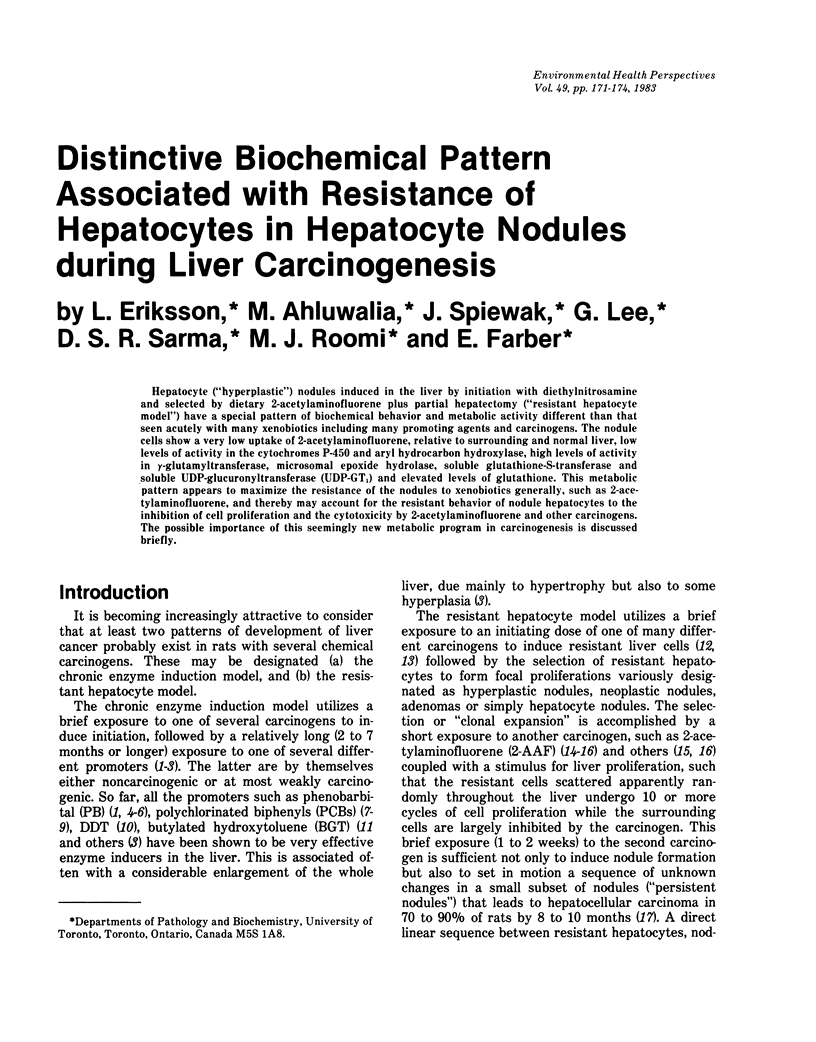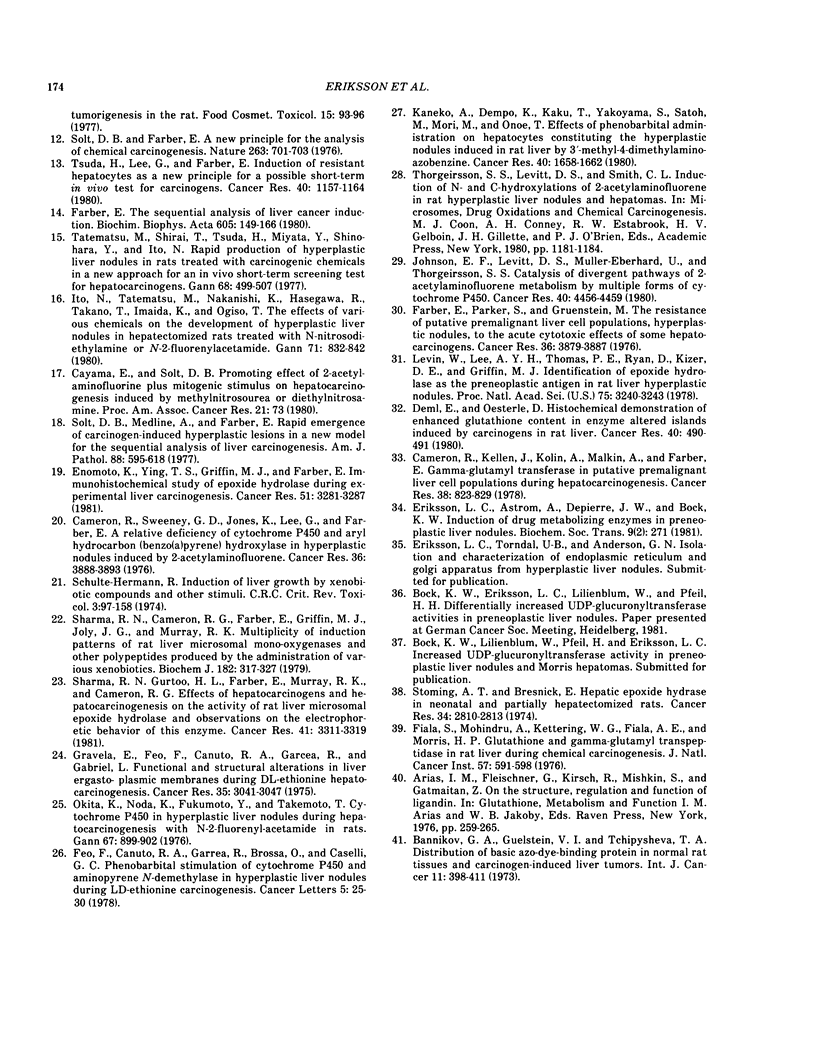Abstract
Hepatocyte (“hyperplastic”) nodules induced in the liver by initiation with diethylnitrosamine and selected by dietary 2-acetylaminofluorene plus partial hepatectomy (“resistant hepatocyte model”) have a special pattern of biochemical behavior and metabolic activity different than that seen acutely with many xenobiotics including many promoting agents and carcinogens. The nodule cells show a very low uptake of 2-acetylaminofluorene, relative to surrounding and normal liver, low levels of activity in the cytochromes P-450 and aryl hydrocarbon hydroxylase, high levels of activity in γ-glutamyltransferase, microsomal epoxide hydrolase, soluble glutathione-S-transferase and soluble UDP-glucuronyltransferase (UDP-GT1) and elevated levels of glutathione. This metabolic pattern appears to maximize the resistance of the nodules to xenobiotics generally, such as 2-acetylaminofluorene, and thereby may account for the resistant behavior of nodule hepatocytes to the inhibition of cell proliferation and the cytotoxicity by 2-acetylaminofluorene and other carcinogens. The possible importance of this seemingly new metabolic program in carcinogenesis is discussed briefly.
Full text
PDF



Selected References
These references are in PubMed. This may not be the complete list of references from this article.
- Bannikov G. A., Guelstein V. I., Tchipysheva T. A. Distribution of basic azo-dye-binding protein in normal rat tissues and carcinogen-induced liver tumors. Int J Cancer. 1973 Mar 15;11(2):398–411. doi: 10.1002/ijc.2910110217. [DOI] [PubMed] [Google Scholar]
- Cameron R., Kellen J., Kolin A., Malkin A., Farber E. Gamma-glutamyltransferase in putative premalignant liver cell populations during hepatocarcinogenesis. Cancer Res. 1978 Mar;38(3):823–829. [PubMed] [Google Scholar]
- Cameron R., Sweeney G. D., Jones K., Lee G., Farber E. A relative deficiency of cytochrome P-450 and aryl hydrocarbon [benzo(a)pyrene] hydroxylase in hyperplastic nodules induced by 2-acetylaminofluorene in rat liver. Cancer Res. 1976 Nov;36(11 Pt 1):3888–3893. [PubMed] [Google Scholar]
- Deml E., Oesterle D. Histochemical demonstration of enhanced glutathione content in enzyme-altered islands induced by carcinogens in rat liver. Cancer Res. 1980 Feb;40(2):490–491. [PubMed] [Google Scholar]
- Farber E., Parker S., Gruenstein M. The resistance of putative premalignant liver cell populations, hyperplastic nodules, to the acute cytotoxic effects of some hepatocarcinogens. Cancer Res. 1976 Nov;36(11 Pt 1):3879–3887. [PubMed] [Google Scholar]
- Farber E. The sequential analysis of liver cancer induction. Biochim Biophys Acta. 1980 May 6;605(2):149–166. doi: 10.1016/0304-419x(80)90002-5. [DOI] [PubMed] [Google Scholar]
- Feo F., Canuto R. A., Garcea R., Brossa O., Caselli G. C. Phenobarbital stimulation of cytochrome P-450 and aminopyrine N-demethylase in hyperplastic liver nodules during LD-ethionine carcinogenesis. Cancer Lett. 1978 Jul;5(1):25–30. doi: 10.1016/s0304-3835(78)80006-8. [DOI] [PubMed] [Google Scholar]
- Fiala S., Mohindru A., Kettering W. G., Fiala A. E., Morris H. P. Glutathione and gamma glutamyl transpeptidase in rat liver during chemical carcinogenesis. J Natl Cancer Inst. 1976 Sep;57(3):591–598. doi: 10.1093/jnci/57.3.591. [DOI] [PubMed] [Google Scholar]
- Gravela E., Feo F., Canuto R. A., Garcea R., Gabriel L. Functional and structural alterations of liver ergastoplasmic membranes during DL-ethionine hepatocarcinogenesis. Cancer Res. 1975 Nov;35(11 Pt 1):3041–3047. [PubMed] [Google Scholar]
- Ito N., Tatematsu M., Nakanishi K., Hasegawa R., Takano T., Imaida K., Ogiso T. The effects of various chemicals on the development of hyperplastic liver nodules in hepatectomized rats treated with N-nitrosodiethylamine or N-2-fluorenylacetamide. Gan. 1980 Dec;71(6):832–842. [PubMed] [Google Scholar]
- Johnson E. F., Levitt D. S., Muller-Eberhard U., Thorgeirsson S. S. Catalysis of divergent pathways of 2-acetylaminofluorene metabolism by multiple forms of cytochrome P-450. Cancer Res. 1980 Dec;40(12):4456–4459. [PubMed] [Google Scholar]
- Kaneko A., Dempo K., Kaku T., Yokoyama S., Satoh M., Mori M., Onoé T. Effect of phenobarbital administration on hepatocytes constituting the hyperplastic nodules induced in rat liver by 3'-methyl-4-dimethylaminoazobenzene. Cancer Res. 1980 May;40(5):1658–1662. [PubMed] [Google Scholar]
- Kimura N. T., Kanematsu T., Baba T. Polychlorinated biphenyl(s) as a promotor in experimental hepatocarcinogenesis in rats. Z Krebsforsch Klin Onkol Cancer Res Clin Oncol. 1976 Dec 9;87(3):257–266. doi: 10.1007/BF00506498. [DOI] [PubMed] [Google Scholar]
- Kitagawa T., Sugano H. Enhancement of azo-dye hepatocarcinogenesis with dietary phenobarbital in rats. Gan. 1977 Apr;68(2):255–256. [PubMed] [Google Scholar]
- Levin W., Lu A. Y., Thomas P. E., Ryan D., Kizer D. E., Griffin M. J. Identification of epoxide hydrase as the preneoplastic antigen in rat liver hyperplastic nodules. Proc Natl Acad Sci U S A. 1978 Jul;75(7):3240–3243. doi: 10.1073/pnas.75.7.3240. [DOI] [PMC free article] [PubMed] [Google Scholar]
- Nishizumi M. Enhancement of diethylnitrosamine hepatocarcinogenesis in rats by exposure to polychlorinated biphenyls or phenobarbital. Cancer Lett. 1976 Sep;2(1):11–15. doi: 10.1016/s0304-3835(76)80004-3. [DOI] [PubMed] [Google Scholar]
- Okita K., Noda K., Fukumoto Y., Takemoto T. Cytochrome P-450 in hyperplastic liver nodules during hepatocarcinogenesis with N-2-fluorenylacetamide in rats. Gan. 1976 Dec;67(6):899–902. [PubMed] [Google Scholar]
- Peraino C., Fry R. J., Staffeldt E., Christopher J. P. Comparative enhancing effects of phenobarbital, amobarbital, diphenylhydantoin, and dichlorodiphenyltrichloroethane on 2-acetylaminofluorene-induced hepatic tumorigenesis in the rat. Cancer Res. 1975 Oct;35(10):2884–2890. [PubMed] [Google Scholar]
- Peraino C., Fry R. J., Staffeldt E. Reduction and enhancement by phenobarbital of hepatocarcinogenesis induced in the rat by 2-acetylaminofluorene. Cancer Res. 1971 Oct;31(10):1506–1512. [PubMed] [Google Scholar]
- Pitot H. C., Barsness L., Goldsworthy T., Kitagawa T. Biochemical characterisation of stages of hepatocarcinogenesis after a single dose of diethylnitrosamine. Nature. 1978 Feb 2;271(5644):456–458. doi: 10.1038/271456a0. [DOI] [PubMed] [Google Scholar]
- Pitot H. C., Sirica A. E. The stages of initiation and promotion in hepatocarcinogenesis. Biochim Biophys Acta. 1980 May 6;605(2):191–215. doi: 10.1016/0304-419x(80)90004-9. [DOI] [PubMed] [Google Scholar]
- Pugh T. D., Goldfarb S. Quantitative histochemical and autoradiographic studies of hepatocarcinogenesis in rats fed 2-acetylaminofluorene followed by phenobarbital. Cancer Res. 1978 Dec;38(12):4450–4457. [PubMed] [Google Scholar]
- Schulte-Hermann R. Induction of liver growth by xenobiotic compounds and other stimuli. CRC Crit Rev Toxicol. 1974 Sep;3(1):97–158. doi: 10.3109/10408447409079856. [DOI] [PubMed] [Google Scholar]
- Sharma R. N., Cameron R. G., Farber E., Griffin M. J., Joly J. G., Murray R. K. Multiplicity of induction patterns of rat liver microsomal mono-oxygenases and other polypeptides produced by administration of various xenobiotics. Biochem J. 1979 Aug 15;182(2):317–327. doi: 10.1042/bj1820317. [DOI] [PMC free article] [PubMed] [Google Scholar]
- Sharma R. N., Gurtoo H. L., Farber E., Murray R. K., Cameron R. G. Effects of hepatocarcinogens and hepatocarcinogenesis on the activity of rat liver microsomal epoxide hydrolase and observations on the electrophoretic behavior of this enzyme. Cancer Res. 1981 Sep;41(9 Pt 1):3311–3319. [PubMed] [Google Scholar]
- Solt D. B., Medline A., Farber E. Rapid emergence of carcinogen-induced hyperplastic lesions in a new model for the sequential analysis of liver carcinogenesis. Am J Pathol. 1977 Sep;88(3):595–618. [PMC free article] [PubMed] [Google Scholar]
- Stoming T. A., Bresnick E. Hepatic epoxide hydrase in neonatal and partially hepatectomized rats. Cancer Res. 1974 Oct;34(10):2810–2813. [PubMed] [Google Scholar]
- Stone D. Structure and function of bacterial and mammalian dihydrofolate reductases. Biochem Soc Trans. 1981 Aug;9(4):271–273. doi: 10.1042/bst0090271. [DOI] [PubMed] [Google Scholar]
- Tatematsu M., Nakanishi K., Murasaki G., Miyata Y., Hirose M., Ito N. Enhancing effect of inducers of liver microsomal enzymes on induction of hyperplastic liver nodules by N-2-fluorenylacetamide in rats. J Natl Cancer Inst. 1979 Dec;63(6):1411–1416. [PubMed] [Google Scholar]
- Tatematsu M., Shirai T., Tsuda H., Miyata Y., Shinohara Y., Ito N. Rapid production of hyperplastic liver nodules in rats treated with carcinogenic chemicals: a new approach for an in vivo short-term screening test for hepatocarcinogens. Gan. 1977 Aug;68(4):499–507. [PubMed] [Google Scholar]
- Tsuda H., Lee G., Farber E. Induction of resistant hepatocytes as a new principle for a possible short-term in vivo test for carcinogens. Cancer Res. 1980 Apr;40(4):1157–1164. [PubMed] [Google Scholar]


